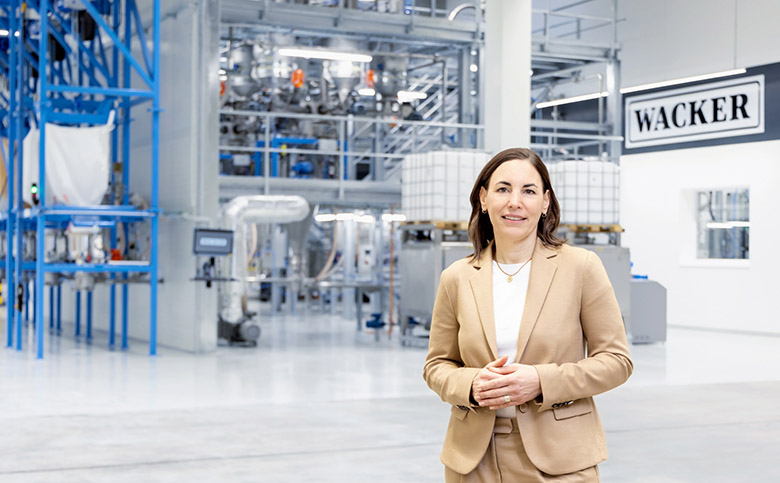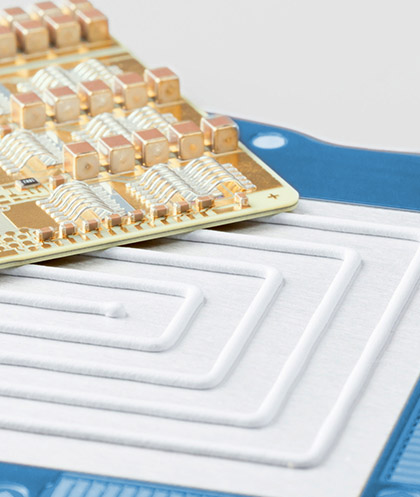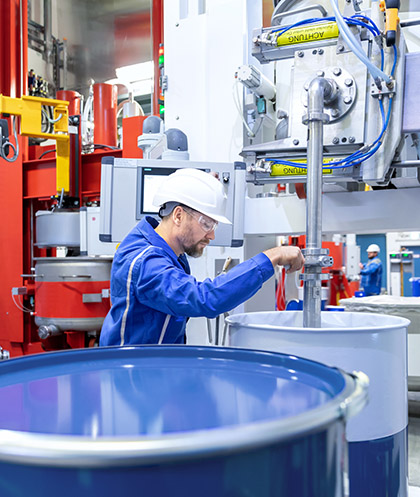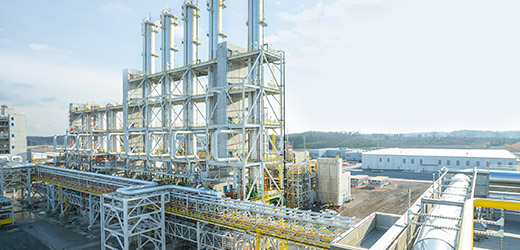Silicones
The Key to Electromobility
Experts predict that 75 percent of all new vehicles sold in Europe and 70 percent of those sold in China will be powered by electric motors as early as 2030. The batteries and power electronics for these electric cars place considerable demand on the materials used. Specialty silicones from WACKER can meet that demand, putting the company in an outstanding position to support the mobility transition.
Henry Ford is known for having invented the assembly line that made gasoline-powered cars affordable for a broad segment of society. That he bought his wife Clara an electric car in 1908 is less well known, however. Indeed, before the internal combustion engine ultimately conquered the market in the early 1920s, electric vehicles were very much in demand.

Today we find ourselves at the dawn of a new era – one you might call Electromobility 2.0. Some 4.3 million battery-driven electric vehicles and plug-in hybrids were sold throughout the world in the first half of 2022 alone. When extrapolated to all of 2022, that corresponds to a 3.7-fold increase over the number of electric cars sold in 2019. And that spectacular growth will continue: based on a scenario that accounts for the share of the market that electric cars currently hold in various countries, the International Energy Agency (IEA) expects over 45 million new vehicles with electric motors worldwide in 2030. If the global community is serious about achieving a climate-neutral economy by 2050, more than 65 million vehicles will need to be sold in 2030, according to IEA calculations.
“Silicones play a major role in electromobility, because its unique properties make electric vehicles more reliable, longer lasting and more efficient,” says Anton Wilhelm, who heads global segment management for the WACKER SILICONES Engineering Silicones unit. Modern electric cars contain more silicone than traditional vehicles, and the role silicones play is expected to grow quite literally weightier: experts from the automotive and supply industries anticipate that the silicone in a battery-operated electric car will outweigh that in a typical gasoline-powered vehicle of today by a factor of as much as four to one. There are a number of reasons for that:
- Efficient heat management of components is a pressing issue in electric vehicles, due in part to the trend toward miniaturization and the resulting higher energy densities. Silicones filled with thermally conductive, inorganic materials are very well suited to meeting that need, serving as gap fillers that draw heat away from the battery. In the form of flowable potting compounds, silicones can be used for producing heat-dissipating circuit boards in power electronics fitted with components such as transformers and inductors.
- Voltage, charging currents and the resulting waste heat of battery-operated vehicles are constantly on the rise, with voltages of up to 800 Volt and charging currents of up to 350 Ampère no longer uncommon. For use in cables, the automotive industry therefore needs extrudable materials that will reliably retain their electrical insulation properties over a very broad range of temperatures and over long periods of time. Silicones are perfect for that.
- Modern cars contain over 100 sensors. These sensors serve as a car’s eyes and ears, delivering important data to keep the vehicle operating smoothly and to maximize safety and comfort. And the significance of these components continues to grow. According to a forecast produced by McKinsey, automotive industry sensor sales are expected to double by 2030. Silicone seals and potting compounds reliably protect sensors and electronic components from moisture, dust and road salt that would otherwise cripple these sensitive components.
- The transition to electric cars goes hand in hand with other trends, which are symbolized by phrases like digital transformation, connectivity and data-based services. All of these require screens as interfaces for communication between people and their cars. Silicones allow displays to work reliably and remain legible, even under thermal and mechanical stress (see interactive diagram).
Modern electric cars contain up to four times more silicone than conventional vehicles
1Electric motor
Coil impregnation
Active cooling
2Power conversion
Encapsulation of electronics
Thermal management
3Display
Optical bonding
4Battery system
Thermal Management
Battery Safety
Battery Sealing & Gasketing
Encapsulation of Electronics
5High-voltage connectors
Electrical insulation
6Sensor/ECU
Encapsulation of electronics
7High-voltage cables
Electrical insulation
8Fuel cell
Sealing bipolar plates
“Our product portfolio puts us in an excellent strategic position to support the rapidly growing business of electromobility in its entirety,” says Julia Henn, director of global segment management for WACKER’s Industrial Solutions unit and head of the Group’s E-Mobility focus project. WACKER is one of the world’s leading actors in the areas of potting compounds and silicone-based thermal interface materials, she goes on to say. “Our years of experience working in this field have allowed us to open up doors to new markets in the automotive industry.”
A Focus on EVBs
Electric-vehicle batteries (EVBs) are primarily installed below the passenger compartment of the car, where they take up a good deal of the space. Often these are lithium-ion batteries. They last eight to ten years and withstand at least 1,000 full charge cycles. The key factor for the battery lifespan, however, is the temperature, both when charging and when driving. According to experts, batteries last longest at temperatures between 15 and 25 degrees Celsius.
Operating and charging the battery generates heat, and in order to prevent that heat from accelerating any undesired processes, it must be dissipated quickly and efficiently. This is accomplished by coupling the battery to a heat sink as completely and with as few gaps as possible. Silicone-based gap fillers from WACKER are ideal for that job, as they can be pressed or injected into the corresponding spaces perfectly, even over large surfaces. In large-scale production, their excellent workability enables short cycle times, which translates to considerable added value. For power electronics, silicone-based potting compounds do more than simply dissipate heat. They also protect components from other environmental factors.

Many prominent automakers now produce their own battery modules and charging infrastructure components, resulting in a corresponding realignment in electric vehicle supply chains. “That opens up new opportunities for us,” says Henn. In the past, the silicone materials WACKER had produced for automotive applications were sold almost exclusively to component manufacturers. Now, however, highly innovative silicone products such as heat-dissipating materials are needed on automakers’ production lines as well. That puts WACKER in direct contact with original equipment manufacturers (OEMs) and also makes the company a frontline partner for new developments in the automotive industry. “We’ve prepared ourselves accordingly,” Henn points out.
WACKER has recently certified portions of its production in Burghausen, Germany, and in Zhangjiagang, China, according to International Automotive Task Force (IATF) standard 16949. Demands are high – particularly those pertaining to quality management – making certification a virtual must for all direct suppliers. WACKER has now joined their ranks, supplying many of its silicone products directly to automakers and their system suppliers.
These materials are customized for the production processes and components of individual automobile manufacturers, and WACKER carries out corresponding development projects with virtually all of these OEMs throughout the world. Another advantage for the Group is that it manufactures nearly all of its own upstream products and intermediates for its specialty silicones, giving the company access to a wide array of raw materials and additives it can use for tailoring silicones to the needs of any given customer.
Its research and development capacities throughout the entire world also give WACKER the ability to respond quickly to new trends and business fields. A new technical competence center for electromobility was dedicated in China a few years ago, and an additional quality control laboratory at the Burghausen site conducts comprehensive testing. What is more, WACKER’s Center of Excellence Electronics in South Korea has a long track record of researching new silicone materials for innovative displays. As Henn notes, “There’s no other competence network like this anywhere in the world. That makes us a preferred development partner for the automotive industry and its suppliers.”
New Approaches to Safety
In collaboration with the automotive industry, WACKER works on a variety of approaches to improve the future safety of high-performance batteries with exceptionally high energy densities. Extreme events caused by an overheated battery should pose as little danger to vehicle occupants as possible. The goal is to delay battery runaway for as long as possible so that all passengers have enough time to reach safety.
WACKER takes a number of different approaches here, working with silicone resins and silicone elastomers alike. While many sealing components in the battery housing are now made of fire-retardant silicone, there are many more ways that silicones can enhance safety.
In one project, for example, the chemical company is developing an innovative coating that addresses all technical and safety aspects of fire protection, efficient use of space, and process automation. The coating is a novel silicone rubber blend that is applied to the internal face of the battery housing and ceramifies completely when exposed to heat. Although it is is just a few millimeters thick, the ceramic layer can withstand temperatures higher than 1,000 degrees Celsius. Should thermal runaway occur, a coating like this protects the housing, giving vehicle safety a substantial boost. “Ceramifying silicones are extremely safe and can be applied by machine, which saves time,” Henn explains. “That could revolutionize how to approach safety for EVBs in the coming years.”
WACKER is currently pursuing a massive expansion of its silicone production capacities – and that also applies to thermally conductive silicone compounds, which are known in the profession as thermal interface materials (TIMs). A new, large-volume production facility will go on stream in Plzeň, Czechia, later this year. The innovative technical foundation for the production method came from WACKER’s own Corporate Engineering and bears the “made in Burghausen” label, so to speak.
Well Connected
In 1964, a commonly sold car made do with 180 meters of cables and a couple of connectors, whereas 3,000 meters of cable and up to 200 connectors are installed in the hybrid and purely electric cars of today. The demands placed on many of these cables and connectors are similar or even greater than those found in gasoline- or diesel-powered vehicles, where they have proven their worth a million times over. With its portfolio of ELASTOSIL®, SEMICOSIL® and WACKER SilGel® silicone rubber products, WACKER offers a wide range of solutions to meet even the challenges posed by electromobility.
Electrical lines have to be connected and disconnected during assembly and maintenance work. The fastest and most reliable way to do this is with electrical connectors, which often have a silicone seal to prevent ingress of moisture, dust and deicing salt. WACKER offers both liquid and solid silicone rubber for applications like these. Electrical cables in a car’s interior quite literally feel the heat, as copper wiring easily rises to temperatures over 180 degrees Celsius when the car is operating at full speed or being charged. No problem for heat-resistant specialty silicones. Cable sheathing and insulating materials made of silicone have other advantages as well: they are extremely flexible and firm, making them ideal for installing in the tightest spaces and around sharp metal edges and mounting fixtures.
Optical Bonding | Always a Brilliant Image
In modern electric cars, the traditional dashboard has given way to a fully electronic counterpart with a screen and communication system. Large, curved displays are now an indispensable element of today’s vehicle interiors.
These screens have to withstand a lot too: vibrations, shocks, jolts, arctic cold and sizzling heat, all while remaining perfectly legible throughout the entire service life of the car. Silicone gels developed in house at WACKER can meet those standards. The silicones bond the entire surface of the display to the cover glass – the touch-sensitive element of touchscreens. The refractive index of silicone gels like these is similar to that of the two adjacent materials, thereby avoiding the distracting reflections that arise in screens where the space between the materials is filled with air.
Optical bonding makes the resulting image far more brilliant than is the case when the display and cover glass are glued to the frame, forming a bond only along their circumference.
Being able to produce within one’s own region is growing more and more important – especially in times hallmarked by supply bottlenecks and a tendency toward protectionism in trade. “Short transport routes are more sustainable than long ones,” stresses Wilhelm. “Car manufacturers are noting more and more that long shipping routes for materials and components are liabilities when it comes to sustainability. Our production sites for liquid and solid silicone rubber in Europe, the US, India, South Korea, Japan and China put us in an outstanding position in that respect.”

The unmistakable rise of electromobility also benefits the climate, of course. According to expert assessments, electric vehicles generate 65 to 80 percent fewer environmentally harmful emissions than cars with internal combustion engines. That argument for buying an electric car did not apply in the early 20th century, when the impact of CO2 in car exhaust was not yet known. People back then appreciated electric cars for a completely different reason, however: drivers didn’t have to roll up their sleeves and crank-start electric cars like they did with the gasoline-powered models of the day.
WACKER SILICONES – Strategy and Goals
Sustainability as a Growth Factor
Growth
Sales to increase by a factor of 1.5 – 2 compared to the past
Profitability
EBITDA margin > 20 percent ROCE > 2x cost of capital
Specific investment focus
Capacity expansion in all regions, innovations, small-scale acquisitions
Focus markets
Electromobility, renewable energy sources, expansion of power grid, energy-efficient construction
WACKER SILICONES is focusing on high-margin specialty products and is expanding its leading position as a fully integrated producer of specialty silicones. The division is already the No. 1 in high-quality solid silicone rubber. Regionalization is another focus and enables the division’s R&D, sales, technical service and production units to respond even faster to local trends and customer requests. The investment in Sico Performance Material, a Chinese specialty silane manufacturer, is a further step in expanding WACKER SILICONES’ portfolio of high-quality specialty products in Asia. The division is the largest producer of silicones in India. The new plant for ready-to-use silicones in Panagarh is the division’s second site devoted to silicones in India. WACKER SILICONES has set itself ambitious targets until 2030: more than 5 billion euros in sales, a roughly 6-10 percent increase in volumes, an EBITDA margin of more than 20 percent, and a return on capital employed that is more than twice our cost of capital. As regards the procurement of raw materials, the division is aiming to become more resilient to price fluctuations and supply-chain problems. In this respect, the expansion of silicon-metal production at our Holla site in Norway and the establishment of local value chains play a key role. Sustainability is increasingly becoming a growth factor. 95 percent of silicone products already meet our sustainability criteria. This figure will be 100 percent by 2030. Biomethanol-based, resource-saving silicones are already an established part of our product portfolio. Silicones are indispensable in a great many sustainable applications, whether we’re talking about electromobility, renewable energy sources, the expansion of the power grid or energy-efficient construction. That is why production is being ramped up across the globe. Small-scale acquisitions are in the pipeline to supplement our portfolio.

